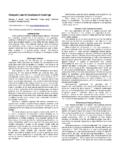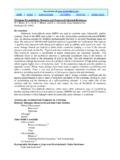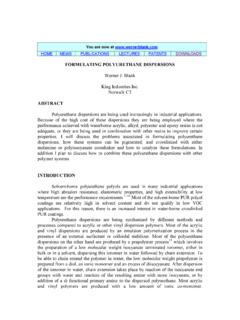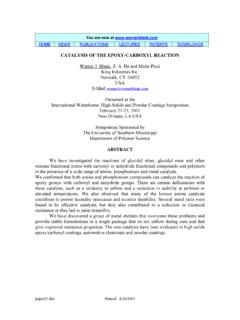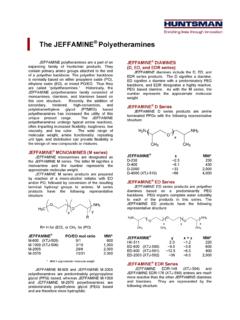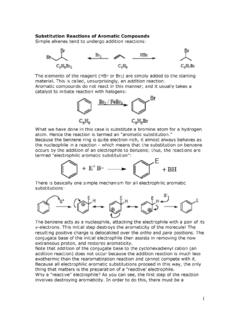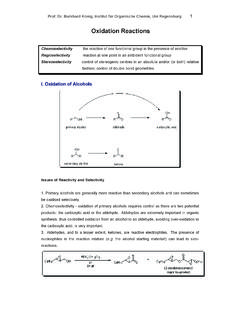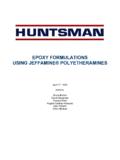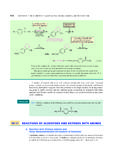Transcription of You are now at www.wernerblank
1 You are now at HOME NEWS PUBLICATIONS LECTURES PATENTS DOWNLOADS Catalysis of the Isocyanate-Hydroxyl Reaction by Non-Tin Catalysts by Werner J. Blank, Z. A. He and Ed T. Hessell King Industries Inc. Norwalk, CT. 06852 USA E-Mail Abstract Tin compounds, especially dibutyltin dilaurate, are in widespread use in coatings as catalysts for the isocyanate/hydroxyl reaction. Because of the high aquatic toxicity of some organotin compounds, there has been an attempt to ban organotin compounds from all coating applications. As a general rule organotin catalysts are not selective, they catalyze the reaction of isocyanates with both hydroxyl groups and water and also catalyze the hydrolysis of ester groups.
2 We are interested in finding alternatives to these catalysts and in developing compounds which exhibit increased selectivity for the isocyanate/hydroxyl reaction. In addition, we are interested in developing materials which give a longer potlife and enhanced reaction rates. We will report on various metal salts and chelates we have investigated, the mechanism of catalysis and application characteristics in both high solids and water-borne applications. We found zirconium chelates activates the hydroxyl groups and catalyze the isocyanate-hydroxyl reaction by an insertion mechanism. This reaction is selective and preferred over the isocyanate-water reaction. This permits the use of this catalyst in waterborne isocyanate crosslinked two component coatings.
3 In addition this catalyst permits very high reaction rate which suggests is use in plural component gun applications. Introduction The catalysis of the isocyanate-hydroxyl reaction has been studied by many authors1 who found that the reaction of aliphatic isocyanates with hydroxyl groups is catalyzed by many metal carboxylates and organo tin compounds. t-Amine catalysis of the reaction of aromatic isocyanates with hydroxyl groups has been practiced for some time and is common for the preparation of flexible polyurethane foams2. This paper also describes the formation of isocyanurate trimer and the side reaction with water. This side reaction with water is a desirable reaction for foam applications because the thus formed carbon dioxide can be used as a blowing agent.
4 In most coating applications side reaction with water is not desirable because it can lead to gassing and blister formation and also to poor crosslinking density. The water reaction of isocyanates is especially troublesome during cure under high humidity conditions or in two component water-borne isocyanate crosslinked coatings. The reaction of 4,4-dicyclohexylmethane diisocyanate in the presence of dialkyltin compounds with water and alcohols was investigated3 in triethylene glycol dimethyl ether and n-methyl pyrrolidinone. This study found selectivity4 of the hydroxyl versus water reaction of between to depending on reaction conditions. One exception was dibutyltin dichloride which gave equal rate constants for both n-butanol and water.
5 The steric hindrance around the catalytic center was found to have strong effects on the rate constants for urethane reactions catalyzed by sulfonium catalysts5. In the cyclotrimerization reaction, this effect on the reaction rate was negligible. The reaction6 of isophorone diisocyanate with alcohols was studied in the absence and presence of dibutyltin dilaurate (DBTDL) and 1,4-diazabicyclo[2,2,2]-octane (DABCO). In the presence of DBTDL the reaction of the secondary isocyanate groups was favored, while in the presence of DABCO the reaction of the primary isocyanate group was preferred. Apparently the relative reactivity of the isocyanate group depends on the mode of catalysis and steric hindrance.
6 The reaction of water with aromatic polyisocyanates is of interest in the formation of polyurethane foams. This reaction7 was studied in diglyme with amine and tin catalysts. Dibutyltin dilaurate and DABCO gave equal reaction rates with water and hydroxyl groups. Phenylmercuric acetate showed exceptional high reaction rates with water. Surprisingly only 70% of the water was found to contribute to carbon dioxide evolution. In water-borne two component coatings8 the formation of urea is a major side reaction. The reaction of polyisocyanates in water-borne two component coatings9 in the presence of different amines was investigated. It was observed that the pKa value of the amine has a large effect on the water-isocyanate reaction and that amines with a higher pKa value show increased reactivity of the isocyanate with water.
7 Dibutyltin compounds are generally recognized to function as Lewis acid catalysts by complexing with the isocyanate10. The mechanism of catalysis of amines has been related to Lewis base catalysis, the amine complexing the alcohol. Indeed a synergistic effect11 of tin compounds with amines has been observed in urethane formation. The observation that the urethane groups formed catalyze12 the hydroxy/isocyanate reaction complicates in establishing a catalysis mechanism. We were interested to develop a catalyst which predominately catalyzes the isocyanate-hydroxyl reaction and not the water-reaction. A suppression of the water reaction could permit the formulation of water-borne isocyanate crosslinked coatings with an improved potlife, a reduction in the isocyanate index and also permit a reduction in variation in crosslink density with aging of the formulation.
8 EXPERIMENTAL Zirconium dionate complexes used in this study were prepared via ligand exchange reactions13 of zirconium compounds with corresponding diketone chelating agents. The different dionate chelating agents were either obtained from commercial sources or were synthesized via the Claisen reaction. Zirconium catalyst A (ZIRC A) is obtained by preparing a solution of a zirconium, tetrakis(2,4-pentanedionato-kO,kO')-, (SA-8-11''11''1'1'''1'1''') complex (ZrAcAc) in 2,4-pentanedione with a metal content of %. Zirconium catalyst B (ZIRC B)is a proprietary zirconium tetra-dionato complex14 in a reactive diluent with a metal content of %. The other chelating agents used in the study are identified in the Results Section.
9 The aluminum chelate catalyst used in this study is an aluminum, tris(2,4-pentanedionato-kO,kO')-, (OC-6-11) complex15 identified as Alch1. The bismuth carboxylate catalyst (Bi oct.) used was a commercially supplied 75 % solution of bismuth tris(2-ethylhexanoate)16 in 2-ethylhexanoic acid. The polyols and polyisocyanates used during the study were commercial materials and were used without further purification. We observed variations in the reaction rates of the uncatalyzed reaction of polyols with polyisocyanates as measured in gel time17. These variations in reaction rate were attributed to catalytic impurities in both the polyol and also the polyisocyanate and the interaction of impurities with the catalyst.
10 Most of the catalyzed reactions were conducted under conditions to minimize the effect of uncatalyzed catalysis. We also used in our study polyols or polyisocyanates from the same batch or we re-tested new batches for uncatalyzed rates. The gel test was performed by mixing the acrylic polyol18 with the catalyst, adding the polyisocyanate (HDI-trimer) crosslinker and sealing the blend in a vial. The vials were immersed in a water bath at 62 C and checked for flow and gelation every 5-10 minutes. Cure studies were conducted on draw down films using a wire applicator. Cure conditions if not indicated were kept at 20-22 C and 50-60 % of relative humidity (RH). Higher temperature cure studies were conducted in a forced air circulating electrically heated oven.
